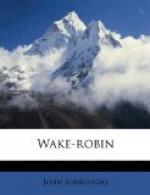The bald eagle, also builds on high rocks, according to Audubon, though Wilson describes the nest of one which he saw near Great Egg Harbor, in the top of a large yellow pine. It was a vast pile of sticks, sods, sedge, grass, reeds, etc., five or six feet high by four broad, and with little or no concavity.
It had been used for many years, and he was told that the eagles made it a sort of home or lodging-place in all seasons.
The eagle in all cases uses one nest, with more or less repair, for several years. Many of our common birds do the same. The birds may be divided, with respect to this and kindred points, into five general classes. First, those that repair or appropriate the last year’s nest, as the wren, swallow, bluebird, great-crested flycatcher, owls, eagles, fish hawk, and a few others. Secondly, those that build anew each season, though frequently rearing more than one brood in the same nest. Of these the phoebe-bird is a well-know example. Thirdly, those that build a new nest for each brood, which includes by far the greatest number of species. Fourthly, a limited number that make no nest of their own, but appropriate the abandoned nests of other birds. Finally, those who use no nest at all, but deposit their eggs in the sand, which is the case with a large number of aquatic fowls. 1866.
V
SPRING AT THE CAPITAL WITH AN EYE TO THE BIRDS
I came to Washington to live in the fall of 1863, and, with the exception of a month each summer spent in the interior of New York, have lived here ever since.
I saw my first novelty in Natural History the day after my arrival. As I was walking near some woods north of the city, a grasshopper of prodigious size flew up from the ground and alighted in a tree. As I pursued him, he proved to be nearly as wild and as fleet of wing as a bird. I thought I had reached the capital of grasshopperdom, and that this was perhaps one of the chiefs or leaders, or perhaps the great High Cock O’lorum himself, taking an airing in the fields. I have never yet been able to settle the question, as every fall I start up a few of these gigantic specimens, which perch on the trees. They are about three inches long, of a gray striped or spotted color, and have quite a reptile look.
The greatest novelty I found, however, was the superb autumn weather, the bright, strong, electric days, lasting well into November, and the general mildness of the entire winter. Though the mercury occasionally sinks to zero, yet the earth is never so seared and blighted by the cold but that in some sheltered nook or corner signs of vegetable life still remain, which on a little encouragement even asserts itself. I have found wild flowers here every month of the year; violets in December, a single houstonia in January (the little lump of earth upon which it stood was frozen hard), and a tiny weed-like plant, with a flower




